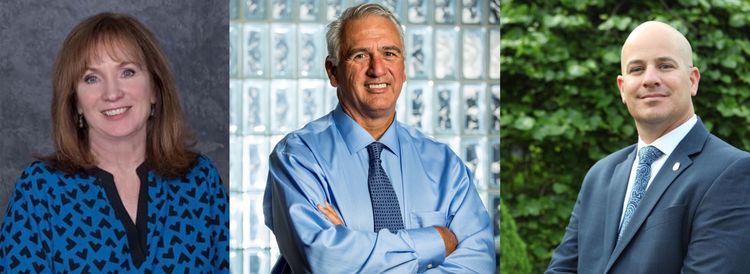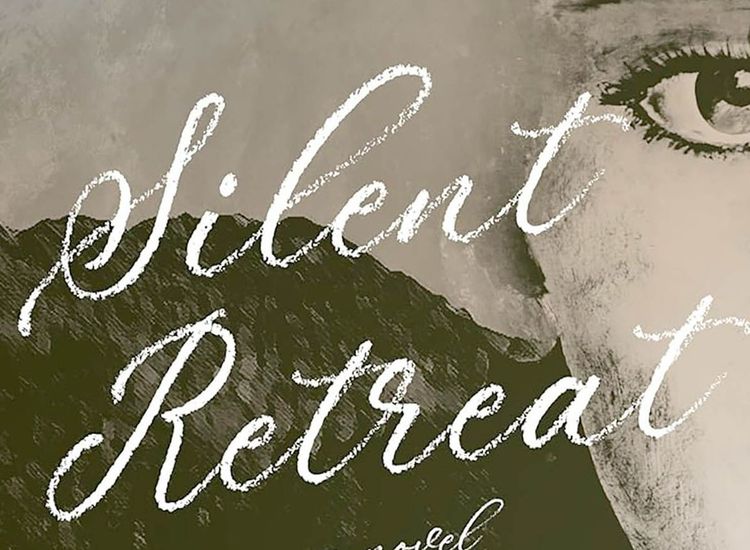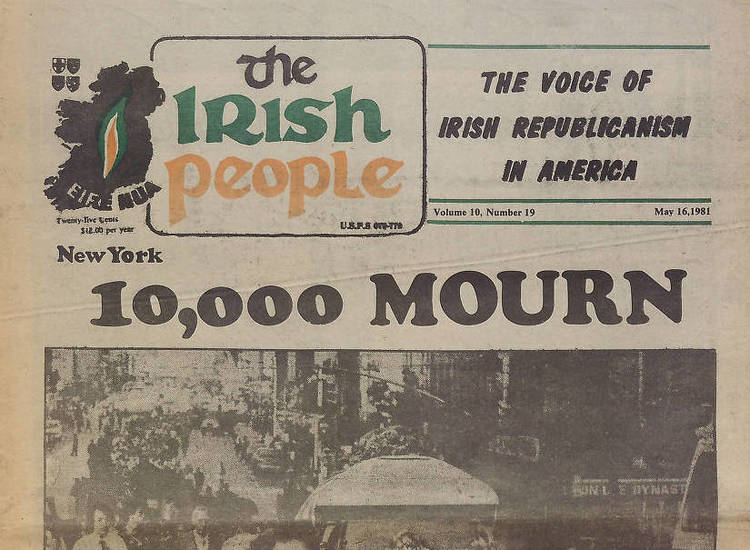The SDLP's Sean Farren being interviewed in 2000 at Government Buildings in Dublin. PHOTO BY ROLLING NEWS.IE
[This article was printed in the Aug. 11-18, 2004 issue of the Irish Echo to mark the 25th anniversary of the Battle of the Bogside. Then New York resident Liam MacNiallais, who died in April 2019, Sean Farren and Henry Patterson were interviewed for it about the events in Derry at the beginning of the Troubles.]
By Peter McDermott
Thirty-five years later, Liam MacNiallais remembers the haze over the city. "It was almost like a fog," he recalled. "There was so much smoke from the tear gas. You could smell the cordite just wafting up." He was a 10-year-old resident of the Creggan, which was up the hill from the Bogside.
The Battle of the Bogside began on Aug. 12, 1969. In his most recent book, "Ireland Since 1939," Henry Patterson writes: "By Aug. 13, 'Free Derry' had effectively seceded from the northern state."
Before it the battle was over, another 24 hours later, the British army was patrolling the streets of Northern Ireland, and has been there since. Derry, particularly the Bogside and the Creggan, which had become "no-go" areas, would never be the same.
It began when the Apprentice Boys, a Protestant organization similar to the Orange Order, marched, as they did traditionally, along Derry's 17th-century embattlements overlooking the Bogside.
Beforehand, the Apprentice Boys received assurances at a meeting with the Derry Citizens Defense Association that the counter-demonstration would be properly stewarded.
The situation in the city was tense. The civil rights movement's most famous early march took place in the city on Oct. 5 the previous year.
There were riots in early January after the Burntollet march and again at Easter. At that time, Samuel Devanney was beaten by policemen as they pursued rioters into his house. (He died in July of his injuries.) The legend "You are now entering Free Derry" appeared on a gable wall for the first time in April. "It captured people's imagination," said MacNiallais, now a Manhattan resident.

Liam MacNiallais pictured in his role as quiz-master at Rocky Sullivan's.
More radical leaders had emerged: Post-war British Labor education policies -- state aid to voluntary schools and grants for college education -- had helped create the new Catholic leaders. Some of them, like the charismatic Derry native and Trotskyist Eamonn McCann, were self-proclaimed revolutionaries.
"There were those who participated from within who hoped they could seize the opportunity to precipitate the complete revolution in their terms, in the sense that this would precipitate the end of Northern Ireland," said Sean Farren, who, at age 30, watched events from Dublin, but was to move to County Derry the following year.
However, the pent-up energies of youth in a city that had 20 percent unemployment was becoming a factor. Soon, as McCann himself said, the "hooligans" were increasingly driving events.
MacNiallais said: "My father was a marshal in the civil rights marches. He and lot of other men went down to the Bogside, trying to make sure there wasn't a confrontation. But the spirit of the day was that the young men and young women had had enough negotiation with people who didn't listen."
Patterson said in an interview that looking back today one can see the ratcheting up of communal tensions: "Reading the papers from January to August, the level of sectarian animosity is rising all the time." he said.
Back in 1966, when he first went to Queens University in Belfast, Patterson, a working-class Protestant from Bangor, Co. Down, became a republican socialist. "My father was a unionist with a small 'u' -- he voted for the [Northern Ireland] Labour Party," he said. Patterson's uncles were Orangemen and mainstream unionists; one, though, was more radical, tending toward the Paisley position.

Patterson was in Derry on Oct. 5, 1968 and joined People's Democracy, the leftist, radical student wing of the civil rights movement, when it was formed. When his relatives met him, they'd ask: "What are you doing with that lot?"
He participated in student civil rights demonstrations in Belfast that felt Protestant animosity at working class Sandy Row and Donegall Place.
"The attitude of the Protestant working class was, here were whingeing Catholics on grants," he said.
Riot
The trigger in Derry on Aug. 12 was said to be the throwing of pennies by the Protestant marchers upon the Bogside. Bottles, stones and other missiles were hurled at marchers and the police defenses for two hours before the inevitable charge.
"It became apparent that the police were going to come in and teach us a lesson," MacNiallais said.
But the residents of the Bogside, who'd already constructed barricades, were ready with stones and petrol bombs. One local dairy is said to have lost 43,000 milk bottles in the preceding four days.
What took place over the next 48 hours was visually similar in certain ways to the May and June "events" of the previous year, the student uprising in Paris. For their battle to control rebellious streets, the RUC were clad and equipped rather like the feared French riot police, the CRS; the demonstrators were youthful for the most part, and indeed led by people, McCann and new MP Bernadette Devlin among them, who'd been student leaders until recently; and the rioters' used stones and bottles, too, as in Paris, and the police responded with a new weapon of crowd control -- CS gas.
The French analogy broke down on at least one front, however. "These were civilians coming in behind the police," MacNiallais said. "It was a clash of two cultures."
He said in the early hours of Aug. 13, car drivers beeped their horns and people ran into the street. He remembered hearing the cry: "They're trying to burn the cathedral," although to this day, he still doesn't know if it was ever seriously threatened.
"But as soon as people heard that -- at this time the people were very Catholic and church-going -- the thought that this might be possible was enough for the men who hadn't gone to the battlefront to get them down there," MacNiallais said. "My father and all the fathers in the street put their clothes on and went down to the Bogside."
After that there were almost no able-bodied men left in the Creggan. Mothers and their children followed events on television. MacNiallais recalled that as he played in the street with a friend, women talked, huddled in groups.
"Rumors were flying around," MacNiallais said. "One woman turned to us and said: 'You're going to have to defend us if the B-men come in.' "
She was undoubtedly joking, but the concern about the B Specials was real. That constabulary was, he explained, like the National Guard. "But these guys hated us with a passion -- that's the sense we got. When our mothers talked about them, you could sense the fear. You could see it in their eyes. They talked about the B-men almost in a whisper."
On an RTE broadcast on the evening of Aug. 13, Taoiseach Jack Lynch said that his government could "no longer stand by and see innocent people injured and perhaps worse."
This started another rumor: "The Irish army was massing on the border. It was definitely coming in. They were going to cross the border and take over Derry. There were stories like that floating around," MacNiallais said. "In fact, the Irish army had set up aid stations for refugees."
The closeness of the Republic to the city was a major factor, Farren believes. "Because it [Derry] was contiguous to the border, because it had a broadly nationalist hinterland, it had about it a confidence, a fearlessness that would not have been present at the time in Belfast, where nationalism is a set of islands," he said.
The help was to come from the broader civil rights movement.
Patterson remembered: "I knew what was happening in Derry. The call went out to have demonstrations in other parts of Northern Ireland. The police would have to pull back."
Soon it was evident that the RUC, just 3,000 strong, were exhausted and demoralized and also that the B Specials, if fully deployed, would only worsen the situation. It was then that the British army was called in.
When that happened, there was a certain confusion among children in the streets of Derry.
Said MacNiallais: "We thought, 'Well, at least they don't hate us. They'll protect us from the B Specials.' "
The mobilization of the B Specials had a sobering effect on the Protestant community, too, taking it to mean that a full-scale uprising against the state was taking place. Patterson has written: "Both communities feared that their ethnic nightmare was about to become a reality in Belfast and acted accordingly."
On the night of Aug. 14, eight people died in the city. The Troubles had begun.
In Derry, the people felt they'd defeated the RUC. "There was an air of excitement, an air of pride, that we were actually standing up for ourselves," said MacNiallais, who today is the quizmaster and Irish-language teacher at Rocky Sullivan's bar.
Reforms
Sean Farren moved to a transformed North to take up a job with the University of Ulster. He became an admirer of Hume, Derry's most prominent politician, in a situation that was unraveling.
"John's attitude always was if you have recourse to violence you must always be able to control that violence," Farren said. "If you bring people onto the streets, there's no predicting what will happen.
"You may not be able to control the forces that you've unleashed; you end up with a far worse situation than the one you were trying to address."
"There was a lot of reform," Farren said of the administration of Prime Minister Terence O'Neill, who'd resigned in April 1969. "But reformers have to be very strong leaders. He wasn't able to convince people that he was doing the right thing."
Said Patterson: "[The civil rights movement's] agenda was explosive for the regime because, although if all its demands were implemented in full it would not have undermined the union with Britain, its implication for traditional Unionist control of Derry, Fermanagh and Tyrone was revolutionary.
"And grassroots unionism could not differentiate between losing control of Derry and Fermanagh and losing control of Northern Ireland."
He said that civil rights campaigners, including the left-wing republicans who became the Officials, genuinely wanted to reform the state. But they failed "to understand the way marches had profoundly sectarian connotations because of the history of communal relations in the North. Grassroots unionists and Orangemen saw civil rights marches as essentially 'Fenian' demos in disguise and therefore wanted the state to apply the traditional approach to republican parades -- that is, ban them."
Patterson was at the meeting that at Christmas 1968 at which radicals discussed and planned the Burtollet march. Still in his ultra-leftist phase, he supported it at the time, though "with grave reservations."
The civil rights leaders had welcomed the O'Neill reforms and his "Ulster at the Crossroads" address, and had declared a truce, which Patterson believes now was the sensible approach.
But the radicals, like PD leader Michael Farrell, were intent on exposing the state as beyond reform. Farrell, Patterson recalled, said those going on the march "should be prepared to get their heads split open, then he said: 'But when we arrive there [Derry] there'll be an insurrection.' "
For Patterson, Burntollet was a "disaster" that worsened sectarian tensions and "stimulated the process of radicalization and violence in Derry which would get far beyond the control of the leadership of the civil rights movement."
Patterson believes also that the short-sighted policies of the London government in August 1969 led to the growth of the Provisionals.
"I think if the British had then, or soon afterward, introduced direct rule, then you wouldn't have had a situation where the British army was propping up the Unionist regime," he said.
Patterson remained a committed leftist, but he broke with PD and came to feel that the nationalist analysis of history could not explain the complexity of the North, much less offer a solution.
Farren, who joined the SDLP in 1972, and was a minister in the recent Northern Ireland Executive, said that the "three-pronged" agenda set out by Hume in the 1970s became the basis of the Good Friday agreement.
"There had to be an accommodation within the North, between North and South, and between Britain and Ireland," he said.
Liam MacNiallais's family, however, became disillusioned with the SDLP. His mother, Mary Nellis, was a candidate for the party, but was unhappy with its response on the prisoner issue. "Her son was being tortured in the H Blocks," MacNiallais said, referring to his brother. She became active in the Relatives Action Committee. Today, Nellis, at 70, is a Sinn Fein Assembly member, continuing an activism that began in the years before the Battle of the Bogside.
MacNiallais said: "The SDLP were too complacent for many years. The nationalist people have woken up and said 'Enough's enough' -- just like our people said in '69."
In 1980, Patterson, a prolific author, became a member of the Republican Clubs, the Workers Party. (He joined those who formed Democratic Left in 1992) He believes the old WP analysis, which emphasized democratic reform, has been vindicated.
"I think that's where the Republican movement is at the moment," he said. "They took a long time getting there, but at least they got there. Thank God for that," he said.
Facing into fresh devolution talks next month, Farren reflected on the tragedy that cost more than 3,600 people their lives. He said the majority of unionists and nationalists never supported violence, and for that reason the North avoided the fate of the former Yugoslavia, where hundreds of thousands died in the 1990s.
"There seemed to have been enough common sense in Northern Ireland to hold us back from going completely over the precipice," Farren said.









